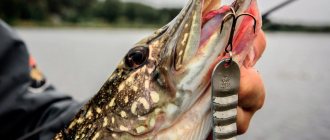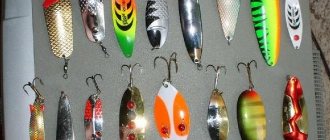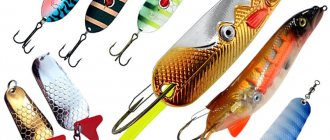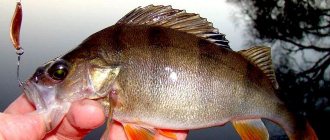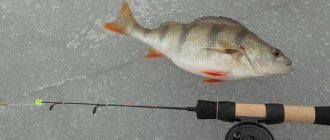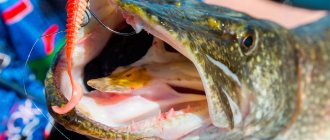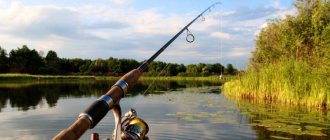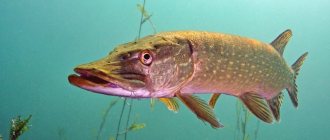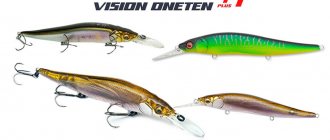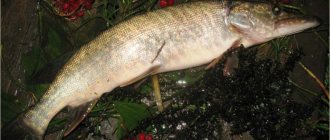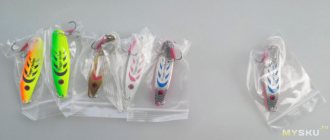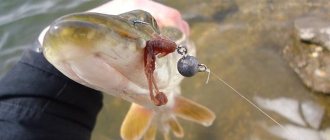Pike is a voracious predatory fish that lives in freshwater bodies of water. The chances of catching a large specimen increase in the fall, because during this period the seasonal feeding season begins and the predator goes hunting. The energetic and hostile behavior of the fish positively affects the quality of the bite. The preferred option for autumn fishing is fishing for pike with a spinning rod.
Autumn on the river
When does pike bite on a spinning rod in the fall?
The predator begins to hunt and eat immediately after the summer heat has subsided. The autumn feeding period of pike is long and stable. The activity of the individual remains until the first frost, and is minimized after the onset of freeze-up.
The biting time varies depending on the month
.
- September. A massive flight of leaves from a birch tree is the beginning of the hunting season for large pike. Bite time is morning and evening dawns.
- October is the high season. The predator moves to depth, and the biting time also shifts - no earlier than the 11th day.
- November. The bite doesn't start until noon. Suitable times for fishing are afternoons and evenings.
In order to catch a trophy specimen, you need to come to the pond in “pike weather” - drizzling rain, light wind, ripples on the water, fresh and cool. The chances increase significantly if similar weather persists for several days.
Posting an oscillating spoon
The wiring of modernized oscillating spinners is no different from the wiring of conventional ones. The best option would be a medium monotonous winding. “Unhooked” ones also perform well in small jerks.
In autumn, quite often the surface of a reservoir is covered with a carpet of fallen leaves. And in this case, the combination of an oscillating spoon with “rubber” turns out to be very useful. The optimal wiring in such conditions is with stops. At the moment of free fall, there are many more bites on horizontal wiring.
In general, jerks, stops, slowdowns or accelerations are encouraged in every possible way when retrieving a modernized spinner. All these techniques should be tried directly on the pond, since oscillating spinners have a great variety of different shapes, and accordingly, their game can be different. Experiment, and then you will definitely catch your fish.
Watch a video about catching pike with spoons in the fall:
Looking for big pike
The minimum size of pike allowed for catching is 35 cm. Such individuals are called “pencils” or “shurogags”.
Predators are considered large, with body size starting from 1 m and weight starting from 7 kg. To reach this size, a pike needs to live 7-10 years. Reference! The largest specimen in our country was caught in 1930 in the waters of Lake Ilmen (Novgorod region).
The pike weighed 34 kg. Fall is the perfect time to find big fish. Such individuals are selective in their habitat and feeding habitat. Trophy specimens are solitary: they do not live or feed with “pencils” or young fish.
It is unlikely to encounter a large pike in shallow water. Such predators prefer deep-sea areas:
- deep holes at the bottom, whirlpools;
- channel channels on the river;
- places where tributaries flow;
- crevices and gorges at the bottom;
- deep creeks;
- sunken trees, snags.
There are high chances of catching a large pike in a large and deep area - a river, a reservoir, a lake. In small ponds or settling tanks (maximum depth no more than 3 m), it is difficult to catch a predator of decent size. There is a small food supply and a lack of places for shelter or hunting. The maximum possible weight of individuals is no more than 5 kg.
Oscillating lures for pike
The “spinning spoons” for pike are quite specific, differing both in the width of the spoon and its length. Large predators are hunted using heavy oscillating spoons about 10 centimeters long.
The advantage of heavy oscillating spinners is that with proper wiring they are able to move at a depth of 6-8 meters, very successfully simulating a weakened or sick fish. Trolling pike with “oscillators” requires constant and even work with the reel.
Every fisherman has “shakers” that, from his point of view, are the most successful for catching pike. A beginner planning to catch pike with an oscillating spoon can be advised to purchase:
- "Lady's" spoons for pike Effxet;
- "Cyclops";
- Japanese lures for pike “Kuusamo Professor”.
Do not rush to put on the swivel a newly purchased spoon, on which the factory varnish shines - the fisherman is more likely to “bite” the brightest baits than the fish. There is a rule on a pond: the brighter and sunny the weather, the more dull the lure the pike will take, and vice versa.
The speed of the oscillating spoon for catching pike should be quite low; it should roll from side to side in the water smoothly and leisurely. Increasing the speed of movement of the spinner will inevitably cause the “shaker” to rotate, which is under no circumstances acceptable for this type of bait.
Gear selection
Autumn fishing begins when there is still vegetation in the reservoir. Long casts in this case are ineffective. The optimal fishing rod at this time is a spinning rod, the length of which does not exceed 240 cm. The action is medium-fast with a dough of no more than 25 g. A regular spinning rod of the middle price category will do. Further cooling and the disappearance of plant elements from the surface also entail a change in suitable gear. Since October, the best option is a spinning rod with a rod length of 270-300 cm for long casts.
The thickness of the fishing line varies: for monofilament - 0.22-0.35, braided - 0.15-0.3 mm. In general, the chosen fishing line should be designed for a weight of 8 to 15 kg. The sharp teeth of a predator can bite through the fishing line. For protection, the tackle is equipped with a metal leash, length – 20-50 cm.
Reels must correspond to the structure and purpose of the gear. Don't save money and buy Chinese counterfeits. The basic options are inertia-free models or multipliers. Suitable capacity is 2500-3000.
Pike baits for spinning in the fall
In autumn, pike are voracious and attack everything that at least in some way resembles food. You can use any bait. The main parameters for choosing them are large sizes, bright colors and good play.
Spinner: rotating and oscillating
Photo: Spoon baits for pike in autumn
Used in reservoirs free of vegetation. What lures to use to catch pike in the fall: rotating models (spinners) are suitable for fishing in September. The recommended size is 2 and 3. Since October, only small individuals have been biting on the turntables. Therefore, at this time they switch to oscillators (oscillating spoons). These are large and heavy baits that attract large predators.
Silicone jig baits
Regular and edible “rubber” is in demand for its price-quality ratio. The following species are suitable for autumn fishing.
- Vibrotail. The stronger the tail plays, the more worthy the catch.
- Twisters. The tail resembles a sickle. Characterized by active play when immersed.
- Lures in the form of worms, leeches, cuttlefish.
Silicone is useful when exploring new places. Such baits are inexpensive and you don’t mind losing them. Therefore, “rubber” is often thrown into muddy water, in areas where roots and snags are hidden under the water.
Video: Catching pike with a jig in autumn
Wobblers
Before and after vegetation settlement, minnow wobblers with a slight depth will be effective. They pass unhindered under the algae, reaching the pike’s hiding places.
Depending on the conditions, different types of wobblers are selected.
- Diving. They work at a depth of up to 6 m. Uniform wiring is recommended.
- Drowning. Use for a wide range of depths, recommended for bottom areas. Jerk wiring is effective.
- Suspenders (neutral buoyancy). Maintain depth during pauses in wiring. The action of the bait resembles the natural behavior of the prey.
Poppers
This is a wobbler that floats on or under the surface. The bait imitates small fish and frogs. Makes a splashing sound.
Pike are selective towards poppers: they can react instantly or not notice the bait. It is recommended to play a measured and delicate game without sudden movements. The use of a popper will be effective only in early autumn, when the pike has not yet gone to depth.
Other baits
For fall pike fishing, jerkbaits are used. This is a bait that looks like a wobbler. It has a specific game. Imitates the behavior of a wounded fish. An additional plus is that the bait cuts off the bite of small fish.
Another option is bucktail. This is a universal bait with colored plumage (fluffy fly with a jig head). Suitable for deep fishing.
There is also a list of baits that will be ineffective in the fall:
- turntables - cling to grass, snags and other obstacles at the bottom;
- mandula - superficial action, the pike does not see the bait;
- spinnerbait – cannot dive to sufficient depth.
How to properly lure and catch pike
As is already clear from the content of the material, trolling methods differ in their execution depending on the gear and fishing method. Spinning fishing is carried out in open water, making horizontal movements. Oscillating spoons are cast in several ways, using a uniform and jerky technique. In turn, uniform drives differ in the parameters of their speed characteristics, and jerk drives differ in the intensity of pauses.
In spring and summer, pike love slow and medium bait feeds. In autumn, the speed can be increased to the limit. Fishing for pike with lures in the fall is characterized by feeding bait from the bottom. That is, after casting, the spinner is allowed to lie on the bottom and after a pause, the animation begins with a jerk. In other periods, the fish likes to pick up bait at the beginning of its move in the water column. They catch fish near the wall of vegetation and in places of bottom anomalies, regardless of the depth, only balancing this parameter by selecting the weight of the bait.
Non-hooking methods are similar to conventional oscillators. They are mainly used for catching pike in the fall, in snags and underwater dead wood. Spinners are rotated in the spring at a fast pace, trying to keep the accessory in the water column. In autumn and summer, pike love spinners launched at the bottom at a slow speed. One of the contradictions of summer fishing with spinners is this negative factor, which reduces the success of fishing in overgrown reservoirs. This type of spoon is caught in flat, shallow areas, free from vegetation and snags. Having thrown, the rotator is lowered to the bottom, after which the petal is wound up with a sharp blow and the cord is wound at different winding speeds.
The work of the spinner is felt by the fisherman as monotonous small vibrations, any failure of which requires another detonation of the bait. From boats, in deep anomalies, vertical spinners are used. The fishing technique involves lowering and raising the product with a certain amplitude in a selected layer of water. The predator reacts to movements by attacking the lure during pauses. When there is ice, the fisherman doesn’t have to think too much about which lure to catch pike with. Only the vertical design allows for rational hunting. The fishing technique is identical to vertical trolling from boats, only winter spinning is used as gear instead of direct contact in open water with the main line of equipment.
What is the best way to catch pike in the fall with a spinning rod?
There are no favorite baits for river predators. An effective option is to stock up on a variety of baits and alternate them periodically.
“Working” autumn baits:
- medium and large size spoon;
- wobblers;
- silicone baits.
These simulations show comparatively better results. The main condition is to select a bait that is at least 10-12 cm in length.
How to properly catch pike with a spoon
Depending on the time of year, day, water temperature and other factors, the correct way to catch a spotted predator with different lures is applicable to the fishing conditions. Let's look at the main types of wiring for oscillating and rotating spoons.
Posting an oscillating spoon to a pike
Posting an oscillating spinner is carried out in 3 options:
- Uniform wiring.
- Wavy wiring.
- A fall.
When driven evenly, the spinner may fluctuate slightly. This game is applicable only in open water, with a flat bottom topography. Wavy, or uneven, wiring requires the skill of the angler. It's more effective. It is good to carry out the fall with large models of spoons, at great depths, where the predator will certainly notice the bright bait. The fall can be supplemented with wavy fluctuations.
About
Basic fishing for pike in autumn
The list of basic and popular ones includes uniform, twitching or jerking, ripping, aggressive, demolition or jumping. Each variety is characterized by a special execution technique.
How to do wiring correctly
| Name | Peculiarities |
| Uniform | Ineffective for pike. There are no active movements, wiring does not attract pike. Used to catch other white predators. |
| Twitching, jerking |
The technique consists of light and smooth movements of the spinning rod horizontally. |
| Riping | The rod is moved in a top-down direction. The advantage of this method is deeper penetration of the bait. |
| Aggressive | The jerks resemble hooking, the bait imitates a fish that is trying to swim away quickly, then returns to its original position with oscillating movements. |
| For demolition | The wiring is carried away by the current. It is important to choose the right weight of the bait so that it does not float up and plow the bottom. |
| Jumping | Jumping movements - sharp twitching of the spinning rod, during which the bait comes off by 5-10 cm. |
Rules for catching pike with a spinner
Spinning pike fishing with a spinner is a very exciting activity, for which even the simplest models of gear are suitable, since it is virtually impossible not to notice the bite of this predator.
However, to get an impressive catch you need to know certain rules regarding tactics and methods of fishing , all of which are discussed below:
- Initially, you will need to fish the selected body of water to determine the location of the prey. To do this, it is necessary to move the spoon through all the secluded places that pike like to use as shelters, among them we can distinguish bottom holes, underwater snags, small creeks, and thickets of vegetation.
- An important step is to determine the depth of the reservoir and the features of its bottom topography. Detection of possible underwater obstacles or significant irregularities is carried out by guiding the load without bait. You will need to remember all the dangerous places; when the spinner passes near them, you will need to carry out an abrupt retrieve.
- On site, it is necessary to check the compliance of the chosen spoon with weather conditions, season, time of day, and also determine its similarity with the fish that pike are accustomed to feeding in a particular body of water. All these factors have a direct impact on the quantity and quality of bites.
- Before use, the spoon must be washed with water taken from the reservoir where fishing is carried out. This will help get rid of all foreign odors that could scare away a cautious predator.
- Fast retrieval is very rarely an effective technique, since pike do not always like to chase fast prey. Driving at an average speed is more effective, sometimes requiring pauses, which is often a signal for an attack. Periodic touches of the spoon to the bottom surface, which creates special vibrations, can also attract the attention of pike.
- When fishing in reservoirs with shallow depths, you need to wait until the bait reaches its maximum depth; usually this does not take much time. As soon as it lies on the bottom surface, you will need to make a sharp swing of the spinning rods, and only after that lead it in the required direction.
- The hook must be sudden, fast and strong, since the pike has a massive and strong jaw, which is very difficult to penetrate even with a sharp and large tee.
- Rewinding the fishing line while the rod is in a vertical position forces the spoon to be raised to the surface of the reservoir; this is necessary if you need to safely overcome any underwater obstacles.
- When fishing at the exits of the rifts, the casting technique is carried out so that the spoon falls directly into the stream, which will take it to a calmer place. If a place was chosen before the roll, then the cast should be made to a point at a distance of 3-5 m above it. However, at low current speeds, you can try to make several test casts over the riffles, since quite large specimens often gather in these places.
Features of pike fishing in autumn
The nights are cold, frequent rains and northern winds cool the water. At the end of September, all layers of water become the same temperature. The oxygen concentration is also equalized throughout the depth. In sexually mature pikes, the reproductive cells begin to mature, and the period of seasonal feeding begins.
Beginning of autumn
The summer fishing season continues. The zhor has not yet begun, the activity of the individuals is mediocre. In September, pike continue to be caught using live bait gear. There is still enough animal food in the reservoirs; fishing with spinning rods is not yet effective.
Middle
Peak pike bite. The water has already cooled down, the temperature has dropped. Pike need to build up a thick layer of subcutaneous fat for wintering. The predator becomes unselective in its choice of food; it reacts to most baits. Therefore, it is advisable to start fishing with spinning rods in October.
Late fall
The trophy large pike in November The predator has already eaten enough, now it has become more careful and attentive. You can catch a large trophy in late autumn only at depth and using deep-sea baits. After the ice crust appears, the pike goes to the bottom and the season ends. However, in reservoirs where the water does not freeze, you can hunt for pike with a spinning rod even in winter.
Oscillating spoon equipment
To make the bait more attractive to predators and more suitable for fishing in difficult conditions, it should be slightly modified. The first and simplest thing is to attach a bunch of bright red threads to the tee of the vibrator. It is believed that red color, or any other bright color, is a strong irritant for pike. True, more often a tee with a red edge is used on “spinners”, but such a modernization is also of interest for oscillating spinners for pike fishing.
Catching pike with a spoon is most often carried out at shallow depths, and a slowly gliding spoon is much more attractive to the predator.
The next step is to reduce the mass of the oscillating spoon, since fishing is carried out at shallow depths and a slowly gliding bait is more attractive to a predator.
Read! Do-it-yourself pike fishing stand
You can significantly modify the game of the oscillating spoon by installing a smaller hook and made of thinner wire. You can also change the winding rings to lighter ones - on most “oscillators” the rings are very large. These modifications give the opposite effect to what is obtained when replacing a conventional tee with a tee with an “edge”. In this case, the working amplitude of the spinner's oscillations increases. It is useful to try both options, because it is difficult to say in advance which one will be more attractive to pike.
Do you need a tee?
A more radical way to modernize an oscillating spoon involves replacing the tee with an offset or double hook with a silicone bait. It would seem that there is nothing complicated: I changed it, hung up the rubber, the spinner became more passable, the number of hooks decreased - everything is great. But this is where many problems arose, the most important of which was the sudden change in the game. Often (in about every second or third case) the spinner either goes into a tailspin or simply turns off from the game.
To avoid such problems, you need to know a few rules. The first and most important thing is the size of the offset hook, the total length of which should be about one and a half, or even two times less than the size of the spoon itself. The same applies to the size of the silicone bait - the performance of the spinner depends no less on this.
The play of an oscillating spoon in a design with an offset hook and “rubber” should be snake-like, that is, describe a sinusoid in the water. Having achieved such a game, we get the most catchable bait. Pike really like this kind of spinner action, especially in the fall.
As for the color of “rubber,” shades of green or brown work best; purple often helps out. But there are exceptions when bright acidic colors (lemon, orange, red) work just as well.
Read! Spinning fishing in winter
You can connect the body of the spinner to the hook not with one winding ring, but with a sequence of two or three, thereby achieving a greater degree of freedom for the entire structure. This option often becomes successful.
